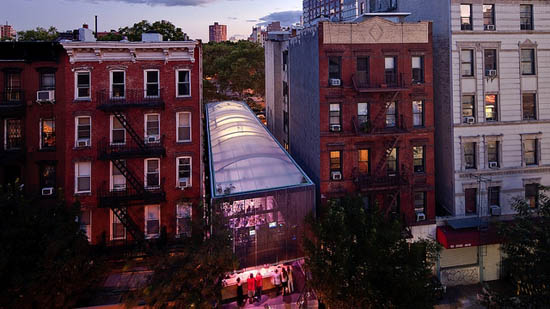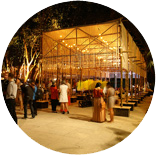New York Lab

The BMW Guggenheim Lab initiated its multi-city tour in New York City’s vibrant neighborhood on the border between the Lower East Side and the East Village. From August 3 to October 16, 2011, the Lab was located in First Park, a New York City Parks property at Houston and Second Avenue. New York Lab Team members Omar Freilla, Charles Montgomery, Olatunbosun Obayomi, and Kristian Koreman and Elma van Boxel of architecture firm ZUS (Zones Urbaines Sensibles) directed the Lab's rich roster of events. The programs transpired in a diversity of forms, including tours, workshops, debates, roundtable discussions, screenings, performances, experiments, and “Comfort Series” lectures given by such urban luminaries as Saskia Sassen, Elizabeth Diller, and Juliet Schor.
Situated on a site once occupied by tenement buildings—which were demolished in the first half of the twentieth century to make way for traffic on Houston Street—the Lab extended into a lot facing First Street, also once the site of one of the area’s many tenement buildings. Abandoned for years and infested with rats after the preexisting tenement building collapsed decades ago, the rubble-strewn vacant lot where the Lab structure sat was previously gated off for precautionary measures. After the New York Parks Department granted the BMW Guggenheim Lab access to use the space for the project, the lot was transformed into the Lab’s temporary home. The lot was cleaned up, covered with paving stones, and enclosed with a new wrought-iron fence. Since the Lab’s close and departure for its next venue, the improvements made to the First Street lot have remained, rendering a formerly unusable city site into an accessible public park space.
The New York Lab drew inspiration from its neighborhood, known for its history as a home to diverse immigrant communities and its present-day mix of residential, work, and leisure spaces. Guided by feedback and recommendations from the curators, experts, and local community, the multidisciplinary New York Lab Team developed a systems approach to the theme of Confronting Comfort. This framework focused on the relevant needs and interests of New York locals as affected by the particular systems, visible and invisible, that work in concert to shape a city.
Kristian Koreman and Elma van Boxel of architecture firm ZUS (Zones Urbaines Sensibles) designed their two-and-a-half weeks of programming around established systems that factor into how cities develop and grow. They explored issues of gentrification, zoning, and equitable urban development practices on a local and global scale. Programs featuring Lower East Side squatters and discussions on the future of the space were just a few highlights. (Watch as Kristian Koreman introduces a week at the Lab themed “neo-globalism.”)
Microbiologist and inventor Olatunbosun Obayomi’s interest in infrastructural systems and the earth’s resources—more specifically, waste and water systems—shed light on consequences of these often overburdened, invisible systems and brought forth ideas of creating more sustainable, decentralized ones. Programs organized by Madrid-based art collective Basurama about waste and New York’s waste systems, as well as a fieldwork session to the New Jersey Meadowlands led by design collaborative spurse, reflected Olatunbosun’s desire to instill awareness of the way individual comforts affect the collective experience.
Omar Freilla, environmental justice activist and cooperative developer, studies systems of power and democracy. At the Lab, he investigated ways of creating a more sustainable, democratic, and egalitarian city by putting the power of decision making in the hands of those most affected. His programs included a workshop on how to start a worker cooperative and an exploration of participatory budgeting—a process enabling New York community members to make direct decisions on part of the public budget. (Watch how Omar brought a day of free community health care to the Lab as visitors received not only massage and acupuncture but also information about healthcare options and resources that few New Yorkers know about.)
Journalist and urban experimentalist Charles Montgomery’s interest focused on more subjective and psychological systems of happiness and wellbeing in cities. His programs pushed the emotional boundaries of comfort and discomfort via tours, workshops on the future of cities and New York’s Lab site, and discussions about how the physical urban environment affects comfort and conviviality. Love Night challenged visitors to trust one another and tested their personal, physical, and emotional limits.
The involvement of local and global participants including neighbors, architects, visionaries, students, passersby, urban planners, institutions, tourists, and individuals allowed the Lab in New York to truly explore new ideas, experiment, and create forward-thinking solutions to the challenges of urban life.
See the Lab’s full calendar of events during its New York stay and view past events in our multimedia section.
Photo by David Heald
© 2011 Solomon R. Guggenheim Foundation

